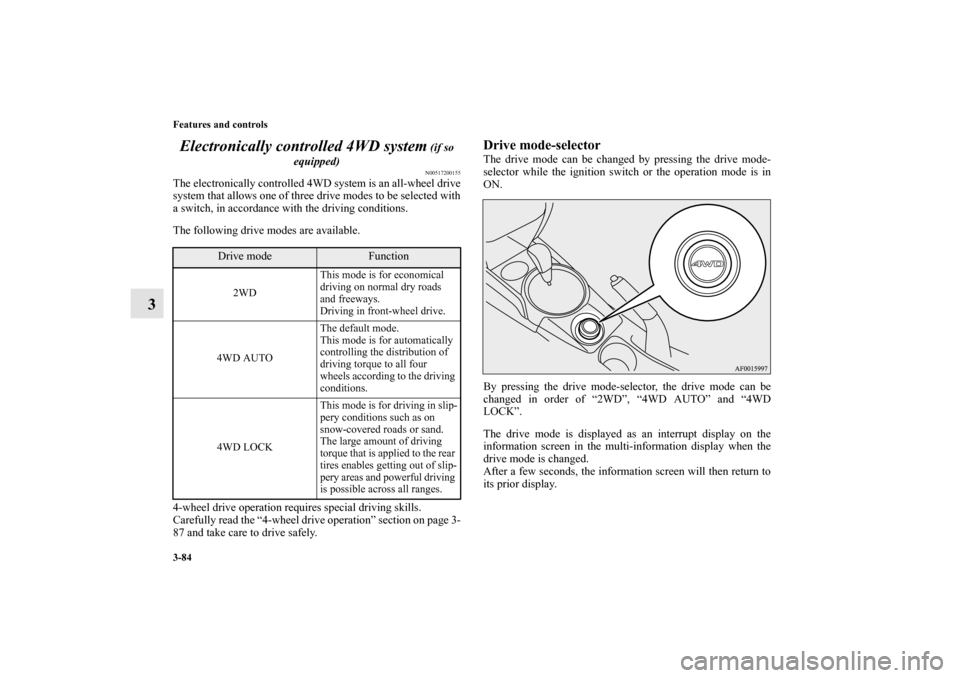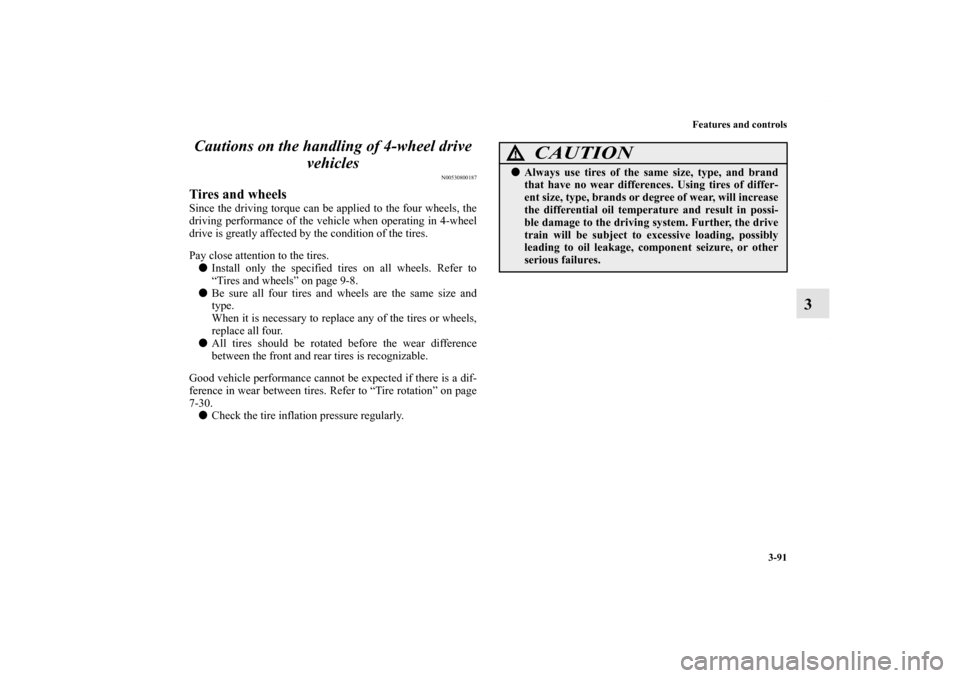Page 181 of 602

3-84 Features and controls
3Electronically controlled 4WD system
(if so
equipped)N00517200155
The electronically controlled 4WD system is an all-wheel drive
system that allows one of three drive modes to be selected with
a switch, in accordance with the driving conditions.
The following drive modes are available.
4-wheel drive operation requires special driving skills.
Carefully read the “4-wheel drive operation” section on page 3-
87 and take care to drive safely.
Drive mode-selectorThe drive mode can be changed by pressing the drive mode-
selector while the ignition switch or the operation mode is in
ON.
By pressing the drive mode-selector, the drive mode can be
changed in order of “2WD”, “4WD AUTO” and “4WD
LOCK”.
The drive mode is displayed as an interrupt display on the
information screen in the multi-information display when the
drive mode is changed.
After a few seconds, the information screen will then return to
its prior display.
Drive mode
Function
2WD This mode is for economical
driving on normal dry roads
and freeways.
Driving in front-wheel drive.
4WD AUTO The default mode.
This mode is for automatically
controlling the distribution of
driving torque to all four
wheels according to the driving
conditions.
4WD LOCK This mode is for driving in slip-
pery conditions such as on
snow-covered roads or sand.
The large amount of driving
torque that is applied to the rear
tires enables getting out of slip-
pery areas and powerful driving
is possible across all ranges.
BK0150700US.book 84 ページ
2012年3月22日 木曜日 午後6時46分
Page 188 of 602

Features and controls3-91
3
Cautions on the handling of 4-wheel drive
vehicles
N00530800187
Tires and wheelsSince the driving torque can be applied to the four wheels, the
driving performance of the vehicle when operating in 4-wheel
drive is greatly affected by the condition of the tires.
Pay close attention to the tires.
� Install only the specified tires on all wheels. Refer to
“Tires and wheels” on page 9-8.
� Be sure all four tires and wheels are the same size and
type.
When it is necessary to replace any of the tires or wheels,
replace all four.
� All tires should be rotated before the wear difference
between the front and rear tires is recognizable.
Good vehicle performance cannot be expected if there is a dif-
ference in wear between tires. Refer to “Tire rotation” on page
7-30. � Check the tire inflation pressure regularly.
CAUTION
!�Always use tires of the same size, type, and brand
that have no wear differences. Using tires of differ-
ent size, type, brands or degree of wear, will increase
the differential oil temperature and result in possi-
ble damage to the driving system. Further, the drive
train will be subject to excessive loading, possibly
leading to oil leakage, component seizure, or other
serious failures.
BK0150700US.book 91 ページ 2012年3月22日 木曜日 午後6時46分
Page 492 of 602
For emergencies6-17
6
8. Lower the vehicle slowly until the tire touches the ground,by rotating the wheel nut wrench counterclockwise. 9. Tighten the nuts in the order shown in the illustration until
each nut has been tightened to the torque listed here.
65 to 80 ft-lb (88 to 108 N•m)
10. Lower the jack all the way and remove it.
CAUTION
!� Never use your foot or a pipe extension to apply
added force to the wheel nut wrench when tighten-
ing the wheel nuts. If you do so, you can over-tighten
the wheel nuts and damage the wheel, wheel nuts
and hub bolts.
BK0150700US.book 17 ページ 2012年3月22日 木曜日 午後6時46分